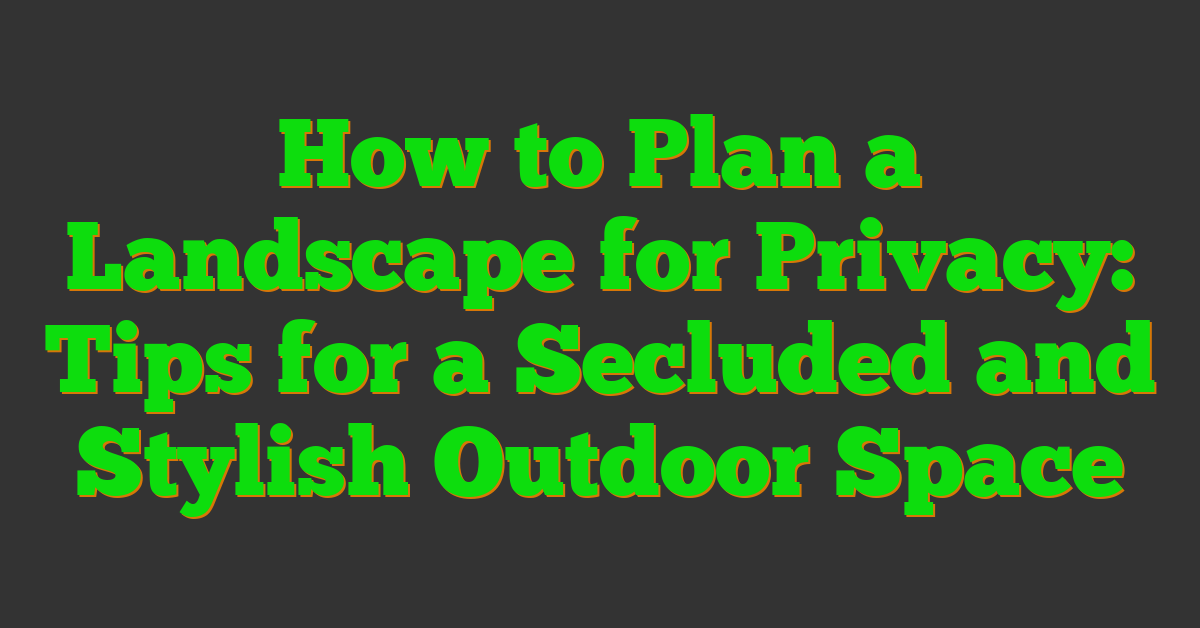Creating a private outdoor space feels like carving out your own little sanctuary. Whether you’re trying to block out noisy neighbors, shield your yard from prying eyes, or simply create a peaceful retreat, a well-planned landscape can make all the difference. The right combination of plants, structures, and design elements transforms your yard into a haven of comfort and seclusion.

When I started planning my own privacy landscape, I quickly realized it’s not just about planting a few trees. It’s about understanding your space, choosing the right materials, and creating layers that blend functionality with beauty. With a thoughtful approach, you can design a space that feels private without sacrificing style or warmth. Let’s dive into the essentials of planning a landscape that offers both privacy and charm.
Understanding The Need For Privacy In Landscaping
Privacy in landscaping enhances the comfort and usability of outdoor spaces. It minimizes visibility from neighboring properties and public areas, establishing a sense of seclusion. This is particularly important in urban or densely populated areas where space is limited.
Incorporating privacy into a landscape design doesn’t isolate the space but instead creates zones for relaxation, gatherings, or recreation. For example, placing natural barriers such as tall hedges or privacy trees like arborvitae or bamboo defines boundaries and reduces external distractions.
Privacy features also contribute to noise reduction. Strategic placement of elements like dense shrubs or water features helps dampen unwanted sounds, fostering a tranquil environment.
Planning for privacy also addresses safety concerns. Landscapes with clear border definitions, such as fences or stone walls, discourage intrusions and enhance security.
Understanding privacy in landscaping means balancing visual and functional elements to create an inviting yet protected outdoor space.
Assessing Your Space And Privacy Goals
Planning for privacy starts with understanding your outdoor space and identifying specific goals. Each yard has unique characteristics that influence how privacy can be achieved effectively.
Identifying Private Areas
I determine where privacy is most needed by pinpointing high-use areas. Spaces like patios, pools, or seating zones often require the most seclusion. I also assess exposure by noting sightlines from neighboring properties, streets, or pathways. High-visibility sections often become a priority for privacy solutions, such as screens or dense vegetation.
Evaluating Natural Features
I examine existing natural elements, such as trees, shrubs, or elevation changes, to understand how they can enhance privacy. Mature trees or sloped landscapes often provide a foundation for secluded designs. In contrast, open, flat areas may need additional structures or plantings to create barriers. By working with the topography and existing greenery, I maximize privacy without overcomplicating the design.
Choosing The Right Plants For Privacy
Selecting suitable plants is crucial for achieving both privacy and aesthetic appeal. I focus on options that provide year-round coverage, quick growth, or decorative elements to ensure a functional yet visually pleasing landscape.
Evergreen Trees And Shrubs
Evergreen trees and shrubs offer consistent privacy throughout the year. I often recommend arborvitae, junipers, or holly, as they create dense screens that block sightlines effectively. Depending on the space, compact varieties like dwarf spruce work well in smaller yards, while larger species, such as Leyland cypress, provide broader coverage for expansive areas. Their year-round foliage makes them highly reliable for maintaining seclusion during all seasons.
Fast-Growing Hedges
Fast-growing hedges are practical for establishing privacy quickly. I prefer planting species like privet, photinia, or boxwood, which adapt well to regular trimming and can form uniform walls. Bamboo is another option; however, I choose clumping bamboo to prevent invasive growth. Positioning these near high-traffic areas or property lines enhances privacy while enabling customization through varied heights.
Decorative Grasses And Vines
Adding decorative grasses and vines enhances privacy while softening the landscape’s appearance. I use grasses like maiden grass or fountain grass, which grow in clumps to provide light screening and texture. For vertical privacy, I rely on climbing vines such as clematis, bougainvillea, or honeysuckle on trellises or pergolas. These elements integrate beautifully with other plants, combining functionality with ornamental value.
Incorporating Fences And Hardscape Elements
Hardscape elements like fences and walls provide immediate, reliable privacy while adding character to a landscape. Their placement and design should complement natural features and fulfill functional needs for seclusion.
Wooden Fences And Trellises
Wooden fences offer flexibility with various styles, heights, and finishes. Solid panel fences create complete privacy, blocking sightlines from neighbors or streets. Lattice-topped designs balance seclusion with light and air, blending functionality with aesthetics.
Trellises support climbing plants like clematis or ivy, creating dynamic green screens. Placing trellises around patios, balconies, or seating areas enhances intimacy in multi-use spaces. Choosing durable woods like cedar or redwood resists weathering and increases longevity.
Stone Walls And Screens
Stone walls define boundaries while delivering durability and a timeless appearance. Dry-stacked stone designs blend into natural landscapes and require minimal maintenance. Mortared walls provide structural stability for uneven terrain or areas exposed to strong winds.
Privacy screens combine materials like metal, glass, or treated wood with clean, modern lines. Modular stone screening systems simplify installation and adapt to various layouts. Positioning these elements strategically, such as near high-use zones, optimizes coverage without closing off the space visually.
« Top Landscape Design Mistakes to Avoid for a Beautiful and Functional Outdoor Space Creating a Japanese-Inspired Garden: Design, Elements, and Maintenance for Tranquility »
Designing A Layered Privacy Plan
A layered privacy plan combines natural and built elements to create a balanced and cohesive outdoor design. By integrating plants with hardscape features and designing spaces for multiple uses, I can achieve both privacy and functionality.
Combining Plants And Hardscapes
Integrating plants with hardscapes enhances privacy while maintaining visual diversity. For instance, I might pair tall evergreen hedges with a wooden fence to create a double barrier. Climbing plants, like clematis or ivy, can cover trellises or lattices, softening the look of hardscapes and adding texture. Additionally, incorporating low-maintenance shrubs or ornamental grasses at the base of walls provides ground-level coverage that complements taller structures.
For noise reduction or wind breaks, I’d use dense plantings, such as bamboo or cypress, combined with stone walls for added durability. Including varied heights in the design ensures layers of privacy while avoiding monotony. By strategically positioning plantings and hardscapes near sensitive areas, such as decks or hot tubs, I can effectively shield these spaces without blocking airflow or sunlight.
Creating Multi-functional Outdoor Spaces
Designing privacy solutions that also serve multiple purposes increases the usability of outdoor areas. For example, I could install a pergola with drapes or climbing plants, creating a private retreat that doubles as a shaded seating area. A row of espaliered trees along a fence line not only provides seclusion but also adds a decorative and space-efficient feature.
To maximize functionality, I often use privacy screens made from slatted wood or metal near outdoor kitchens or dining zones. These screens block views while offering structural support for hanging planters or lighting. In smaller spaces, vertical gardens act as a privacy wall and a decorative statement, enhancing both the space’s appearance and its utility. By combining privacy elements with versatile designs, outdoor areas remain practical and inviting.
Maintenance Tips For Your Privacy Landscape
Proper upkeep ensures your privacy landscape remains both effective and visually appealing. Regular maintenance increases plant health and helps preserve the functionality of privacy features over time.
Pruning And Trimming
I focus on pruning and trimming regularly to maintain the shape and density of hedges and shrubs. For plants like arborvitae or boxwood, I remove dead or overgrown branches to promote fresh growth and maintain consistent coverage. I also trim evergreen trees annually to encourage healthy development, especially if they’re forming a natural barrier. With vines on trellises or fences, I manage their growth by redirecting and trimming excess stems, ensuring they don’t overwhelm the structure or neighboring plants.
Seasonal Care
Seasonal care allows me to adapt maintenance strategies based on weather and plant needs. In spring, I fertilize the soil to boost recovery from winter dormancy and inspect for any pest or frost damage. During summer, I water consistently, especially for fast-growing or water-sensitive plants like privet hedges. For fall, I remove fallen leaves and debris from around plants to prevent mold, and I prepare for winter by mulching around roots to protect them from freezing temperatures. I also ensure hardscape elements, like fences or walls, are inspected annually for wear and are properly cleaned or sealed as necessary.
Conclusion
Creating a private outdoor space is about more than just adding barriers; it’s about designing a sanctuary that reflects your needs and style. By blending natural elements with hardscapes and focusing on thoughtful placement, you can achieve a balance between seclusion and beauty.
With proper planning and regular maintenance, your landscape can remain both functional and visually appealing for years to come. A well-designed privacy landscape doesn’t just shield your space—it transforms it into a personal retreat you’ll love to enjoy.
















